When you’re building your own electric guitar kit, one of the most fascinating aspects to explore is how pickup position affects electric guitar tone in kits. Whether you’re chasing searing lead tones, warm jazz textures, or something truly your own, the location and configuration of your pickups can have a dramatic effect on your instrument’s voice. In this article, we’ll dive deep into how pickup position, output, and distance shape tone — and how to tweak these variables in your DIY guitar kit build for optimal results.
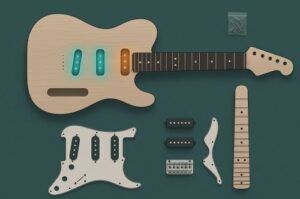
** Here’s a little transparency: Our website contains affiliate links. This means if you click and make a purchase, we may receive a small commission. Don’t worry, there’s no extra cost to you. It’s a simple way you can support our mission to bring you quality content.**
As an Amazon Associate, I earn from qualifying purchases.
Understanding the Anatomy of an Electric Guitar Pickup
At its core, a pickup is a magnetic transducer — it converts string vibrations into an electrical signal that can be amplified. Most electric guitars use either single-coil or humbucker pickups, each with distinct tonal characteristics. The placement of these pickups along the guitar body plays an essential role in determining the tonal outcome.
Explanation of Pickup Positions: Neck, Middle, Bridge

Electric guitars often have pickups installed in three primary locations:
- Neck Position: Closest to the fretboard; captures warmer, rounder tones with a fuller low end.
- Middle Position: Located between the neck and bridge; blends characteristics of both ends and offers a balanced tone.
- Bridge Position: Closest to the guitar’s bridge; captures brighter, sharper, and more treble-heavy tones with added attack.
Each position is essentially “listening” to the string from a different perspective. The neck hears the broad, flowing vibrations near the middle of the string, while the bridge hears the tighter, more intense movements closer to the end.
How Different Pickup Positions Capture Sound Frequencies
The physics are simple: string vibration amplitude is greater near the neck and tighter near the bridge. This means:
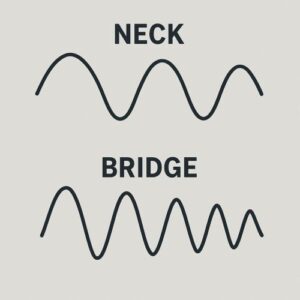
- Neck pickups produce mellow, bass-heavy tones.
- Bridge pickups result in bright, cutting tones with more treble.
- Middle pickups provide a tonal compromise, and when combined with the neck or bridge (as in “quack” positions on a Strat), create phase-based tonal uniqueness.
The Role of Pickup Position in Shaping Guitar Tone
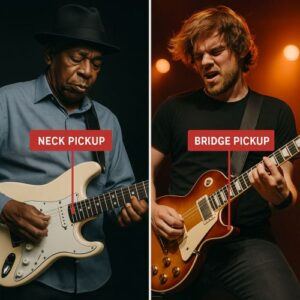
Because pickup placement determines which part of the string’s vibration is being captured, your tonal palette dramatically shifts depending on which pickup is active. Rock and metal players often favor the bridge for aggressive attack, while blues and jazz guitarists may lean toward the neck for warmth.
The Impact of Pickup Output on Sound Quality
Defining Pickup Output: What It Means and How It’s Measured

Pickup output refers to the electrical signal strength a pickup sends to your amp. This is typically measured in millivolts or by DC resistance (in ohms). Higher output pickups are often wound with more coil wire, resulting in a stronger signal.
The Relationship Between Pickup Output and Tone Clarity
More output doesn’t always mean “better.” While high-output pickups can drive amps harder and generate more distortion, they can also sacrifice clarity and subtlety. Lower-output pickups maintain more detail and dynamic range, which is often ideal for clean or bluesy tones.
Effects of High vs. Low Output Pickups on Tone Quality
- High-output pickups: Greater distortion, heavier midrange, potential muddiness.
- Low-output pickups: More articulate and cleaner, brighter highs, wider dynamic range.

Why Musicians Choose Pickups with Varying Outputs
Some guitarists prefer hot pickups for aggressive genres like metal and punk. Others stick with vintage-output pickups for expressive blues or country playing. It’s all about matching the pickup’s personality with your playing style and desired tone.
Key Elements Affecting Electric Guitar Tone
Exploring the Primary Factors Influencing Electric Guitar Tone

Tone isn’t solely about pickups. A guitar’s sound is the sum of many parts:
- Pickups (type, position, output)
- Body and neck wood
- Bridge and nut materials
- Potentiometers and capacitors
- String gauge and even pick attack
Comparing the Impact of Pickups with Wood Type and Hardware
In kits, you can choose different tonewoods, like mahogany, alder, or basswood, each with distinct resonance. However, pickup placement and type tend to have a more immediate and noticeable impact than wood, especially with solid-body guitars where the pickups do most of the tone work.
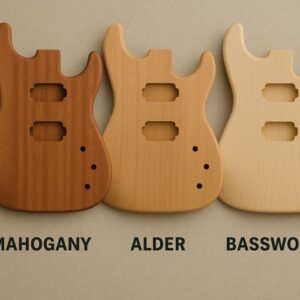
Analyzing the Significance of Electronic Components in Kits
The quality of electronics—pots, switches, and wiring—can’t be overlooked. Higher-grade components reduce signal loss and noise. Kits that come with upgraded electronics offer a solid base for future tone upgrades.
Understanding the Customizable Nature of Tone in Kits
One of the joys of a DIY electric guitar kit is the freedom to shape your tone. From pickup selection to pot value (250k vs 500k), there’s room for experimentation, making each build truly personal.
The Role of Pickup Distance and Height Adjustment
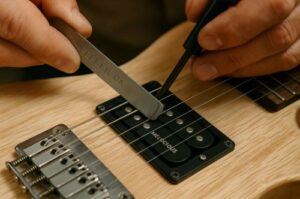
Explaining Pickup Distance: Measured from Strings
Pickup height is measured by the space between the pickup’s top surface and the guitar strings—usually done when pressing down the last fret. It’s a subtle tweak with massive sonic consequences.
Effects of Closer vs. Further Pickup Distances on Tone
- Closer pickups = louder output, more attack, more compression — but may distort easily and lose clarity.
- Further pickups = softer output, more dynamic response, increased clarity — but may sound too thin if too far.
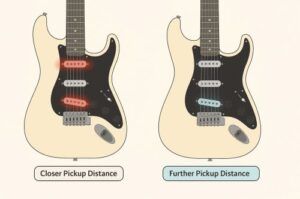
How Adjusting Pickup Height Changes Sound Dynamics
Even a millimeter of difference can alter your tone. Many players set their bridge pickup closer for brightness and output, and the neck slightly further for warmth and balance. Always listen and adjust.
Techniques for Optimizing Pickup Distance in Kits
When assembling your kit:
- Start with manufacturer-recommended settings.
- Use your ears to fine-tune each pickup height.
- Play across your amp settings—clean, crunch, lead—and adjust accordingly.
- Don’t forget string gauge can affect the ideal height, too.

Crafting Your Unique Sound: Choosing the Right Setup
Steps to Identify Your Desired Tone Color and Why It Matters

Begin with the end in mind. Do you want creamy lead tones or biting rhythms? Think about your playing style and what inspires you. This will guide your choices in pickup position, output, and height.
Practical Tips for Experimenting with Position, Output, and Distance
- Try swapping pickup positions if your kit allows (e.g., using a neck humbucker in the bridge).
- Pair low-output pickups with overdrive pedals to keep clarity with grit.
- Adjust pickup height while recording short riffs to A/B your results.
Stories from Musicians: How They Discovered Their Signature Tones

Eric Clapton famously used the “woman tone” by dialing back tone knobs and using the neck pickup. Meanwhile, Eddie Van Halen customized his guitar with a single high-output humbucker in the bridge—no tone control at all. Everyone finds their voice differently, and so can you.
Building Confidence in Personal Sound Customization
Tone chasing is part science, part intuition. Your kit is a blank canvas — don’t be afraid to test different setups until your guitar sounds like you. As you build more guitars, your ear and confidence will grow.
Final Thoughts…
Understanding how pickup position affects electric guitar tone in kits opens a world of tonal customization for builders and players alike. Whether you’re diving deep into pickup materials (see our guide on choosing the perfect nut material for tone) or adjusting your bridge and neck setup (read our bridge setup guide), every small tweak helps define your sound. Explore other tonal elements like fretboard inlays (check out unique inlay ideas) or even choosing the right guitar kit tier (compare budget vs. premium kits). Your tone journey starts with curiosity — so get building, tweaking, and playing!

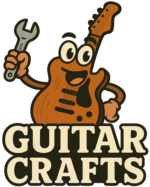

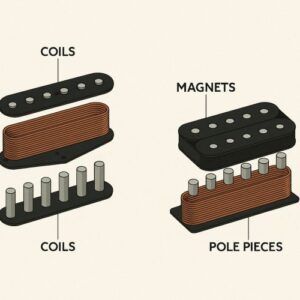

This was such an insightful read! I’ve always known pickup type played a role in tone, but I didn’t realize just how much the actual position on the guitar affects the sound. Your breakdown of neck, middle, and bridge positions really made it click for me, especially the physics behind string vibration. I can see how experimenting with pickup placement could open up a whole new palette of tones. Have you found that certain pickup positions respond better to specific genres or playing techniques, or is it really just down to personal preference?
Thanks a lot! I’m glad the breakdown helped connect the dots. It’s one of those things that seems small until you hear the difference. I’d say it’s a mix of both personal preference and genre. For example, neck pickups tend to shine for blues and jazz because of their warmth, while the bridge position really cuts through for rock and country. The middle can be a sweet spot for funk or clean pop tones. That said, players are always breaking the “rules,” so experimentation is half the fun.
Thanks again,
~Wayne
I really enjoyed this article—super clear and inspiring for anyone building their own electric guitar kit! I especially loved how you illustrated the “listening” differences of each pickup position: the neck pickup offering warm, rounded tones; the bridge delivering sharp, high-treble attack; and the middle balancing the two beautifully My Electric Guitar Kits Site. Your breakdown makes it so easy to experiment effectively when crafting tone. I’m wondering: have you found that thin-shanking the middle pickup—like on a Strat—adds any distinctive quirks or “quack” tones you’d recommend trying out in a DIY setup?
Thanks so much! I’m glad the article made pickup positions feel approachable.
It’s amazing how much tone you can shape just by experimenting.
And yes, thinning the middle pickup on a Strat-style setup definitely adds that classic “quack” in-between tone. It’s especially fun for funk, clean rhythm parts, or when you want a bit of sparkle without overpowering the mix. In a DIY setup, it’s a small tweak that can give your guitar some really distinctive character—worth experimenting with if you want those iconic in-between sounds.
Thanks again,
~Wayne